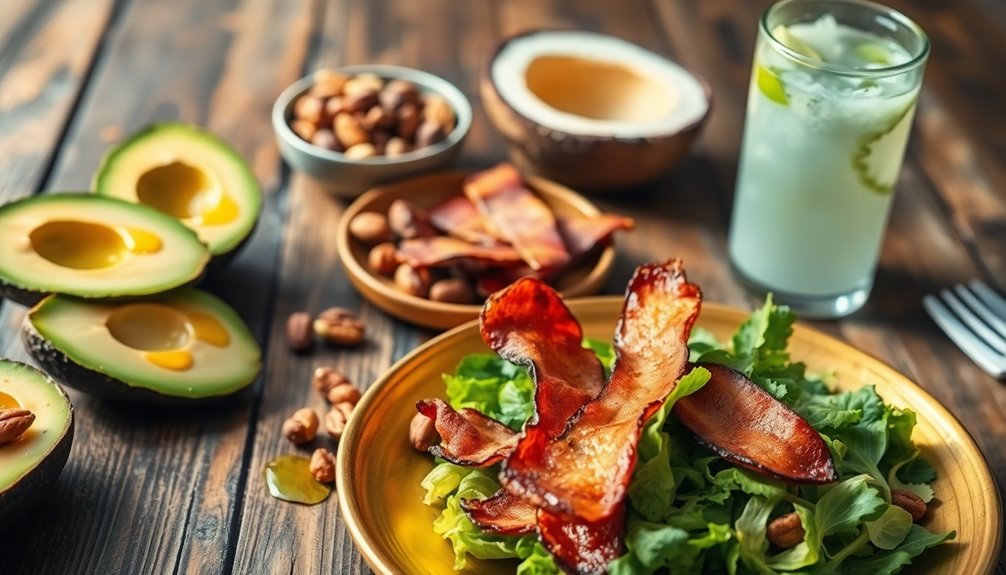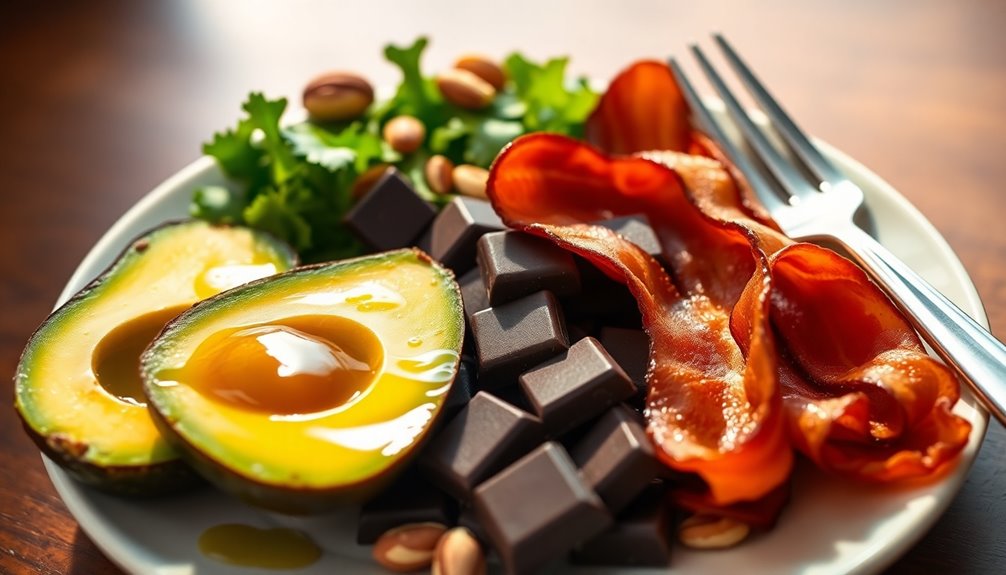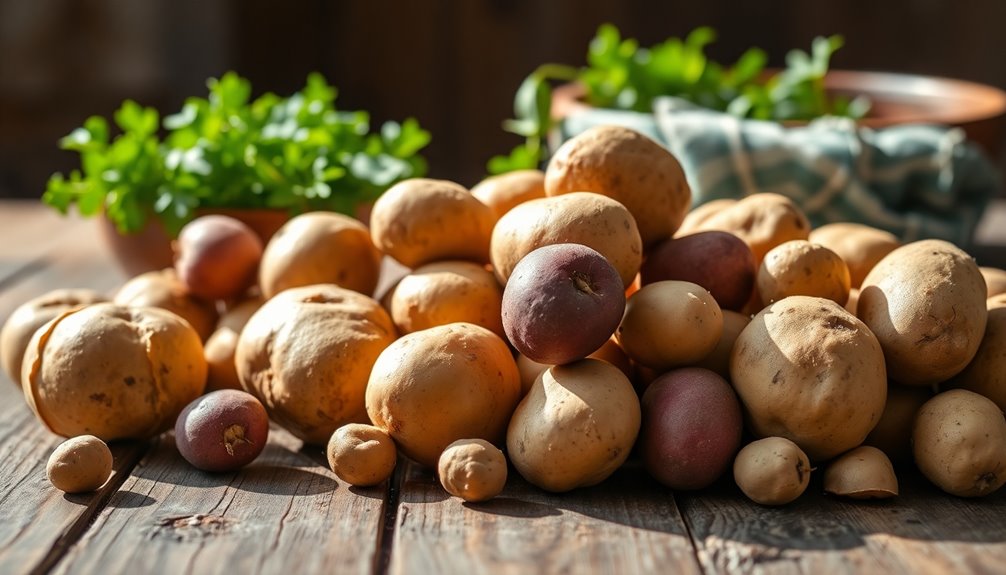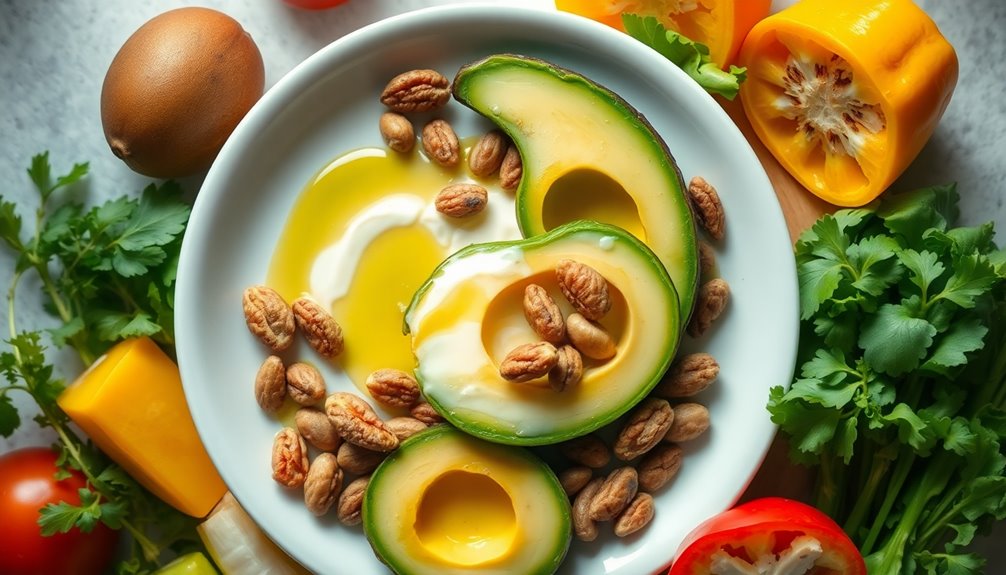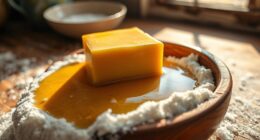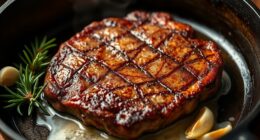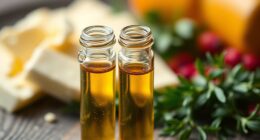Eating fat doesn't mean packing on pounds; in fact, it can help you lose weight! By choosing healthy fats from sources like olive oil, avocados, and fatty fish, you can improve your body composition and feel fuller longer. A high-fat, low-carb approach may reduce body fat while enhancing your overall health. Just remember, it's all about balance. Mindfully integrating these fats into a calorie-controlled diet is key. You'll discover success stories and practical tips that can transform your approach to eating fat for weight loss—keep exploring to learn how to make this work for you!
Key Takeaways
- Incorporate healthy fats like monounsaturated and polyunsaturated fats from sources like olive oil and fatty fish to promote weight loss.
- Focus on low-energy density foods, such as fruits and vegetables, to enhance fullness while maintaining a caloric deficit.
- Engage in regular exercise to boost calorie burn, but be mindful of overestimating its impact on weight loss.
- Adopt a flexible diet approach, such as the 80/20 balance, to maintain long-term commitment to healthy eating habits.
- Utilize anti-inflammatory foods like berries and turmeric to support overall health and facilitate weight loss through reduced inflammation.
Understanding High-Fat Diets
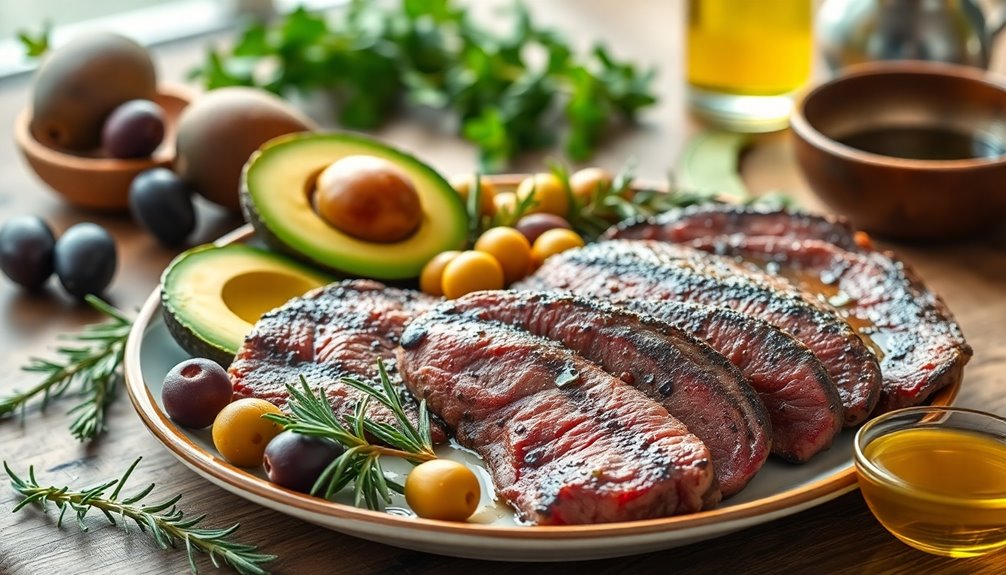
When you think about high-fat diets, you might picture greasy foods and unhealthy eating habits, but that couldn't be further from the truth. High-fat diets can actually include a variety of healthy fats that are essential for your body.
There are three main types of fats: saturated, monounsaturated, and polyunsaturated. Saturated fats come from foods like cheese and meats, while monounsaturated fats are found in olive oil and nuts. Polyunsaturated fats, abundant in fatty fish and certain oils, also play a crucial role in your nutrition. A recent study suggested that a balanced high-fat diet can significantly improve your body composition and reduce inflammation. Incorporating seeds like chia, which are high in omega-3 fatty acids, can further enhance the benefits of a high-fat diet. Additionally, including nutrient-rich ingredients like avocados can provide essential vitamins that support overall health. Chia seeds also add fiber content to your meals, which contributes to digestive health and satiety. Consuming a variety of vegetables like kale can also enhance nutrient intake while following a high-fat diet.
A balanced high-fat diet, with one-third of each type of fat, can significantly improve your body composition and reduce inflammation. Incorporating sources of healthy fats, such as avocados and walnuts, not only enhances your meals but also supports your health.
Caloric Balance Explained

Understanding how to incorporate healthy fats into your diet is just one part of the equation when it comes to weight loss. The key to shedding pounds lies in maintaining a proper caloric balance. Calories are units of energy from food, and if you consume more than your body uses, you'll gain weight. To lose weight, you need a caloric deficit, which means taking in fewer calories than your body expends.
Physical activity plays a crucial role in tipping this balance. Regular exercise boosts your calorie burn, but be cautious; it's easy to overestimate how many calories you've burned. For example, a 20-minute jog might only burn around 190 calories—often offset by a single high-calorie snack. Additionally, muscle mass decreases with age, which can lead to lower calorie needs and make weight management more challenging. Engaging in regular physical activity helps maintain muscle mass, supporting a higher metabolism. Incorporating low carb high protein options into your meals can also assist in maintaining muscle while promoting fat loss. Furthermore, adopting mindfulness practices can help reduce emotional eating, which often sabotages weight loss efforts. Turmeric, known for its anti-inflammatory properties, may also support an overall healthier lifestyle, potentially aiding in weight management.
Moreover, food choices matter. Opt for low-energy density foods like fruits and vegetables to feel fuller with fewer calories. Conversely, high-energy density foods, such as cakes and fried foods, can lead to weight gain.
To manage your caloric intake effectively, track what you eat and adjust portion sizes accordingly. By making mindful choices, you can achieve a sustainable caloric balance that supports your weight loss journey.
Effects on Body Composition
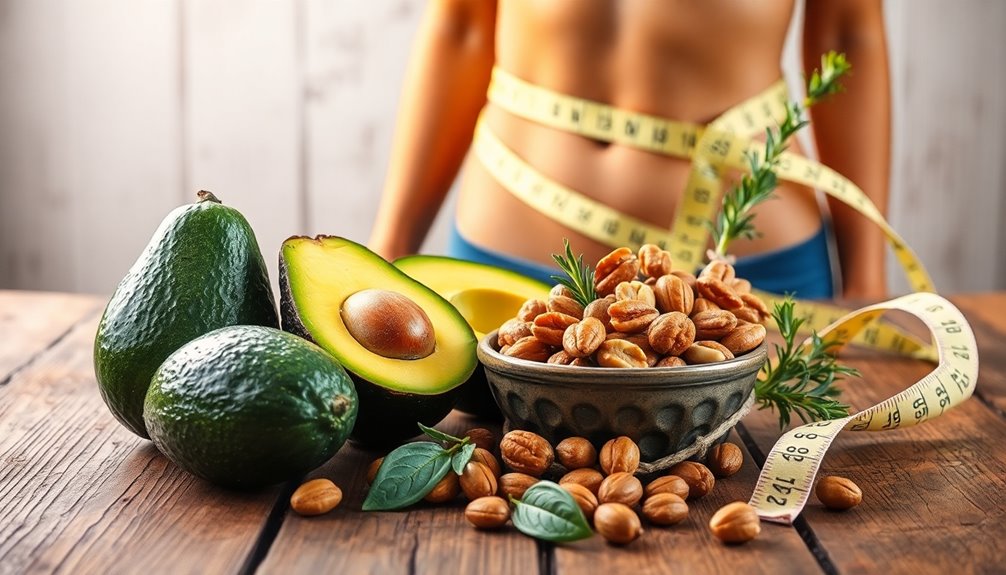
High-fat diets can significantly impact your body composition, often leading to increased body weight and fat accumulation. Even under isocaloric conditions, you might notice significant weight gain when consuming a high-fat diet.
In fact, short-term studies show that these diets can induce early weight increases compared to control and high-carbohydrate diets. This weight gain correlates with higher body adiposity, meaning you'll likely store more fat.
While some people experience body mass reduction on low-carbohydrate, high-fat (LCHF) diets, this isn't universal. The LCHF diet may reduce body fat effectively, but you mightn't see a drastic change in overall body weight. Interestingly, the LCHF group in a recent study experienced a body fat reduction of 8.6% after 12 weeks, highlighting its potential effectiveness.
If you switch to a low glycemic load diet, you could achieve better fat distribution, particularly reducing intra-abdominal fat, regardless of total weight change.
However, metabolic changes from high-fat diets, such as insulin resistance and reduced fat oxidation, can complicate your body composition goals. Engaging in high-intensity exercise can help offset some of these effects by boosting fat oxidation.
Ultimately, how your body responds to dietary fats varies, influenced by both diet and exercise.
Weight Loss Success Stories

Weight loss success stories often inspire and motivate others on their journeys. Many individuals have transformed their lives by adopting effective diet plans, showcasing the power of commitment and healthy choices.
For instance, one person lost an impressive 130 pounds by combining a low-carb, high-protein diet with intermittent fasting. They eliminated sugar and white foods, focusing on lean meats, green beans, and low-fat cottage cheese while mastering portion control. This individual also found that increasing their protein intake was a game-changer in reducing appetite and promoting satiety.
Another success story highlights how joining support groups like Optavia helped someone shed 187 pounds. With family backing and consistent reminders for healthy snacking, they achieved steady weight loss over two and a half years.
Their journey emphasizes that making permanent lifestyle changes, such as incorporating more fruits, vegetables, and healthy oils, is crucial for long-term success.
Flexibility also plays a role in weight loss. One individual lost 189 pounds by following a nutritarian diet, allowing for an 80/20 balance of healthy and indulgent foods.
This approach, combined with regular exercise and timely protein intake, led to lasting results. These stories prove that with the right strategies and support, you too can achieve your weight loss goals.
Cardiovascular Health Risks
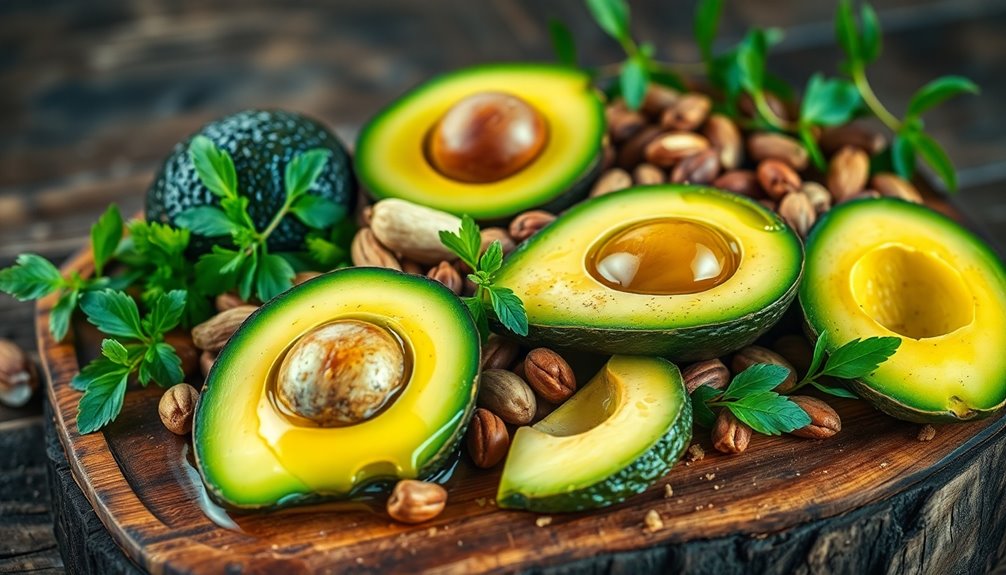
Making healthy lifestyle changes not only aids in weight loss but also significantly impacts cardiovascular health. When you consume a high-fat meal, your blood vessels can experience immediate changes. Red blood cells may alter in size and shape, developing spikes that can damage your blood vessels. This disruption leads to an increase in reactive oxygen species, impairing red blood cell function. Elevated myeloperoxidase (MPO) levels are linked to a higher risk of atherosclerosis and heart attacks. Additionally, high-fat diets are associated with an increased risk of heart disease and atherosclerosis.
Saturated fats can raise your LDL (bad) cholesterol, increasing the likelihood of heart disease and stroke. If you regularly eat high-saturated fat diets, you could face long-term cardiovascular risks. While some individuals may tolerate full-fat dairy without adverse effects, it's generally safer to choose reduced-fat versions if you're aiming to lower LDL cholesterol.
Moreover, high-fat meals can trigger inflammation, similar to an infection response. This inflammation, combined with reduced blood vessel elasticity, significantly heightens your heart disease risk.
Therefore, focusing on a diet low in saturated fat and high in fiber is essential for maintaining heart health and reducing disease risk.
Choosing Healthy Fats
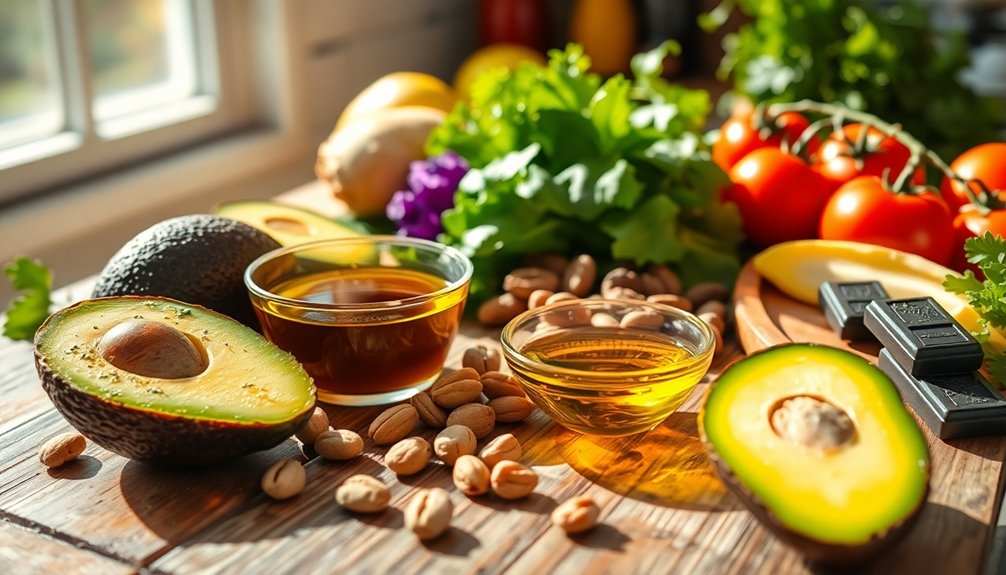
When it comes to maintaining a healthy diet, choosing the right types of fats can make a significant difference in your overall well-being. You'll want to focus on unsaturated fats, which include both polyunsaturated and monounsaturated fats. These healthy fats can help decrease bad LDL cholesterol while increasing good HDL cholesterol, ultimately reducing your risk of cardiovascular disease. Additionally, a diet rich in healthy fats can support kidney stone prevention as part of a balanced approach to overall health. Moreover, including high fiber foods like chia seeds in your diet can enhance digestive health. Furthermore, incorporating herbal alternatives for botox-like effects into your routine can also promote skin hydration and radiance.
Incorporating sources of healthy fats into your diet is easier than you might think. Enjoy fatty fish like salmon, sardines, and herring, which are rich in unsaturated fats. Use liquid plant-based cooking oils such as olive, avocado, and canola oil. Snack on nuts and seeds, and don't forget about avocados, a delicious source of monounsaturated fats. Additionally, juices like carrot juice can also enhance skin elasticity, complementing your healthy fat intake for better overall health.
Healthy fats also play a crucial role in weight loss. They provide energy, help you feel full longer, and regulate blood sugar levels, preventing spikes and cravings. Additionally, fat serves as a primary energy source that aids in weight reduction by utilizing fat deposits.
Practical Dietary Tips
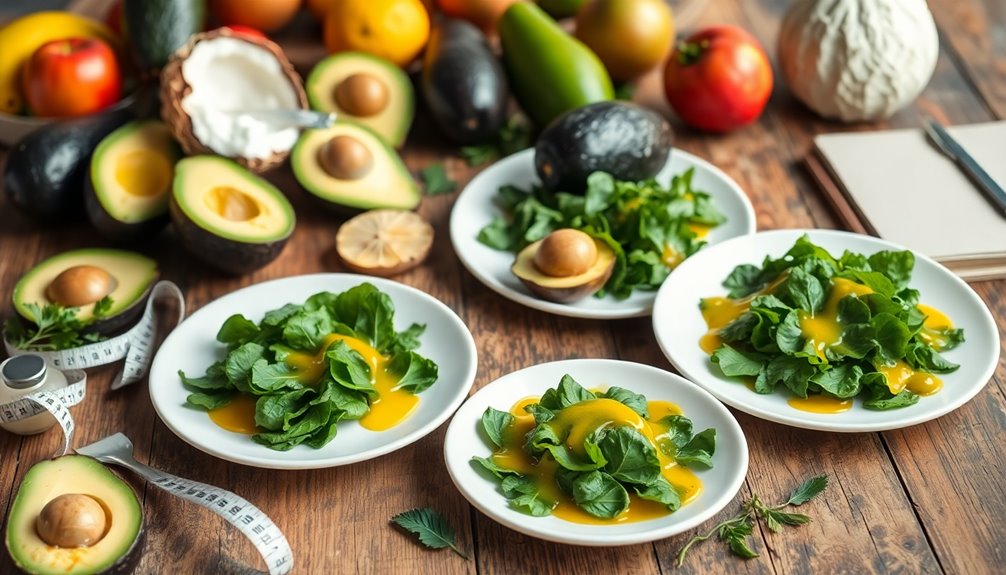
Incorporating healthy fats into your diet is a great start, but knowing how to apply practical dietary tips can further enhance your weight loss journey.
Begin by cooking methods—grill, bake, poach, or steam your meals instead of frying. When using oil, measure it with a teaspoon or opt for an oil spray to keep your portions in check. Trim visible fat and remove the skin from meat before cooking to reduce extra calories. Additionally, using lower-fat options can significantly help in reducing your overall fat intake. It's also beneficial to focus on healthy fats like avocados and olive oil for better energy and satiety, as these fats can help promote ketosis during your weight loss journey. Including fresh juices made from vegetables and fruits can provide essential nutrients while keeping calories low. Moreover, choosing antioxidant-rich foods can further support your overall health during this process.
When shopping, compare food labels to select items lower in fat, and choose lean cuts of meat like turkey breast. Opt for lower-fat dairy products or alternatives, and skip that extra cheese on your pizza in favor of veggies or seafood.
When dining out, swap large whole milk coffees for "skinny" versions and avoid creamy dishes. Instead, go for tomato-based curries or steamed options, which often contain fewer carbs and calories.
For snacks, trade high-fat items like chocolate for fruit or low-fat yogurt. Finally, base your meals on high-fiber carbohydrates and include plenty of fruits and veggies to keep your calorie intake in check while ensuring variety in your diet.
Reducing Inflammation Naturally

Reducing inflammation naturally can significantly enhance your overall health and support your weight loss journey. Start by incorporating anti-inflammatory foods into your diet. Berries like blueberries and cherries are packed with antioxidants, while fatty fish, such as salmon, provide omega-3 fatty acids that help lower inflammatory compounds. Cruciferous vegetables like broccoli and kale are also great choices. Including whole, nutrient-dense foods in your meals can further amplify the anti-inflammatory benefits. Additionally, maintaining a healthy diet can lead to positive changes in your body's inflammatory markers. Aromatherapy using pleasant scents can also promote relaxation and emotional well-being, which may support your weight loss efforts. In particular, honey varieties like Manuka honey are known for their potent antibacterial properties, which can aid in reducing inflammation. Using products like acne patches may also help keep skin irritation at bay, allowing for a more focused weight loss journey.
Spices and beverages can boost your efforts too. Turmeric, with its active compound curcumin, is known for its anti-inflammatory effects. Ginger and green tea, rich in antioxidants, further support your body's fight against inflammation.
Don't forget about dark chocolate; its polyphenols contribute to reduced inflammation when enjoyed in moderation.
Weight loss itself plays a vital role in reducing inflammation. Even small weight reductions can lower levels of inflammatory markers in your body. Adopting a balanced diet rich in polyphenols, nuts, legumes, and healthy fats won't only help you shed pounds but also combat inflammation.
Lastly, consider topical remedies like aloe vera or oatmeal baths to soothe inflammation externally.
Frequently Asked Questions
Can I Eat Whatever I Want on a High-Fat Diet?
You can't just eat whatever you want on a high-fat diet. While healthy fats are encouraged, moderation is crucial.
Focus on incorporating monounsaturated and polyunsaturated fats from sources like olive oil, nuts, and fatty fish, while avoiding trans fats and limiting saturated fats.
Balance your fat intake with other nutrients and watch your overall calorie consumption. Stick to whole foods, and remember that not all fats are created equal!
Will a High-Fat Diet Help With Cravings and Hunger?
A high-fat diet can affect your cravings and hunger levels, but results vary.
While some people find that it helps them feel fuller longer, others may experience increased cravings due to the brain's reward system being activated.
Unsaturated fats, especially omega-3s, can enhance satiety signals, but the combination of fat with sugar might lead to overeating.
How Quickly Can I Expect to See Weight Loss Results?
You can typically expect to see weight loss results within the first few weeks of starting a new diet.
In the initial phase, many people lose around 1-2 pounds per week, primarily due to water and glycogen loss.
After about 4-6 weeks, weight loss may slow to a healthier rate of 0.5-1 pound per week as your body shifts to burning fat.
Staying consistent with your diet and exercise will help maintain progress.
Is Exercise Necessary While Following a High-Fat Diet?
Yes, exercise is necessary even on a high-fat diet.
While these diets can help you feel fuller and support fat loss, regular physical activity is crucial for maintaining weight and overall health.
Aim for at least 150 minutes of moderate-intensity exercise each week.
Incorporating movement into your daily routine, like walking or taking the stairs, can further enhance your results and promote better cardiovascular health.
Exercise and diet together create a balanced approach to wellness.
Are High-Fat Diets Suitable for Everyone, Including Athletes?
High-fat diets aren't suitable for everyone, including athletes.
If you're an endurance athlete, you might benefit from increased fat oxidation during long events.
However, if your focus is on high-intensity performance, you could struggle due to reduced glycogen stores.
It's essential to consider your individual needs and goals, along with your sport's demands.
Before making changes, consult a nutritionist to determine what's best for your performance and recovery.
Conclusion
Incorporating healthy fats into your diet can be a game changer for weight loss and overall health. By understanding how to balance your caloric intake and choosing the right fats, you can achieve your weight loss goals while improving your body composition. Remember, it's not just about cutting calories; it's about making smarter food choices. With the right approach, you can enjoy delicious meals, reduce inflammation, and feel great on your journey to better health.
